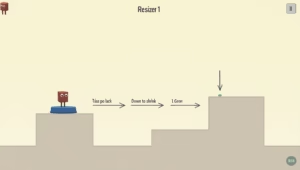What Is Resizer hooda Math
Resizer is a math game. You move shapes. You make them small. You make them big. You use keys. You try to fit the shape into a box. That is your goal.
→ How It Works
You start with one shape. It can be a square, triangle, or circle. You can walk left or right. There are buttons on the floor. You stand on them to change size. Press up to grow. Press down to shrink.
There are no scores. Only levels. No timer. No points. No rush. Just you and the puzzle.
Each level has one path. One answer. You must find it.
What The Game Teaches
Resizer looks simple. But the ideas are not. These are the key lessons:
→ 1. Size and space logic
You must think about how shapes change when they grow. A big shape cannot fit through a small hole. A small shape cannot press a big button.
This teaches spatial sense. Many kids lack this. This game gives that practice.
→ 2. Cause and effect thinking
One move can change everything. If you press the wrong button, you may get stuck. You must try. Then think. Then try again. This builds slow logic.
→ 3. No help = deep problem solving
Resizer gives no hint. No guide. No friend. You are alone. You must try until it works. This forces brain use. Many games talk too much. Resizer does not. That is good.
What Works Well

→ 1. Pure design
The game is clean. Just blocks, buttons, and shapes. That helps kids focus. Many games add noise. This one removes it. Less sound. Less color. More thought.
→ 2. One tool = many uses
The resize button does many things. Make small to walk. Make big to reach. Use size to move, lift, or break. One idea, used ten ways. That is rare in math games.
→ 3. Level design is fair
Early levels are simple. They teach one rule. Later ones test mix of rules. But never unfair. No luck. Only skill. Many kids’ games use tricks. This one uses brains.
→ 4. Quiet pressure
There is no score. But if you do it wrong, you must restart. That soft pain is enough. No red X. No yelling. Just try again. That helps calm kids stay calm.
What Fails or Feels Wrong
→ 1. No math shown
Resizer is on a math site. But it does not show numbers. It teaches logic, yes. But kids do not know they are learning. Some will play and forget.
→ 2. Not enough words for teachers
If a teacher wants to use Resizer in class, they get no guide. No idea list. No teaching sheet. The game is silent. Good for kids, bad for adults.
→ 3. Early quit risk
Some kids will stop after 5 levels. They may think it is boring. Because nothing happens. No sound. No reward. Only shape and size. Some kids need more fire.
→ 4. No help for wrong move
If you make a bad move, there is no “undo.” You must restart whole level. That builds grit, but also makes some kids mad. A redo button would help.
→ 5. Same look in every level
Every level uses same box, same ground, same color. This makes game feel slow. Kids who like change may get bored fast.
Hidden Math Ideas Inside Resizer
→ 1. Geometry in action
When shape moves, it shows size, shape, and angles. No words, just action. Kids who play may later see shapes in books and say “Oh! That’s like the game.”
→ 2. Measurement by feel
You see how much space each size takes. How big is “too big”? You feel it. No ruler, but real math. You see space and volume.
→ 3. Ratio logic without saying ratio
You learn what happens when you grow 2x. Or shrink to half. These are ratios. But no one tells you. You just know it. That’s strong learning.
→ 4. Programming-style thinking
Step-by-step moves. If this, then that. Puzzle order. This is how coders think. Resizer teaches it quietly. No need for code blocks.
→ If You’re A Parent or Teacher
Do not call this “just a game.” It builds brain power. But don’t expect the game to do your work. You must guide the child. Ask them what they did. What they tried. Where they got stuck. What worked. Use paper. Draw levels. Sketch shapes. Talk size.
The game gives the test. You give the talk. That is the combo.
→ If You’re A Developer
Use this model. Make games with clean logic. One tool, many puzzles. No fluff. Build smart. Reward with progress, not coins. Kids like real wins. Not shiny tricks.
→ If You’re A Student
Play slow. Think long. Try many ways. It’s okay to restart. That’s the game. You don’t need to be fast. You need to see the steps. That’s where the math lives.
What Resizer Gets Right That Other Games Miss
Many kids’ math games use cartoon, sound, stars, points. They try to teach math with noise. Resizer is quiet. Pure. Focused.
It is not fun like a race. But it is fun like a puzzle. It makes you feel smart when you win. Not lucky. Not fast. Smart. That is rare.
What Resizer Could Do Better
Add a level map. Add a simple hint. Add teacher tips. Add shape labels like “square,” “circle,” “big,” “small.”
Kids should see the word with the shape. That builds math words.
Maybe change color or background every few levels. Keep brain fresh.
Past the Noise
Resizer is not a loud game. But it is a strong one. It gives small minds hard work. If guided well, it teaches deep things.
No need for flash. No need for score. Just logic, shape, and space.
It does one thing. And it does it well.